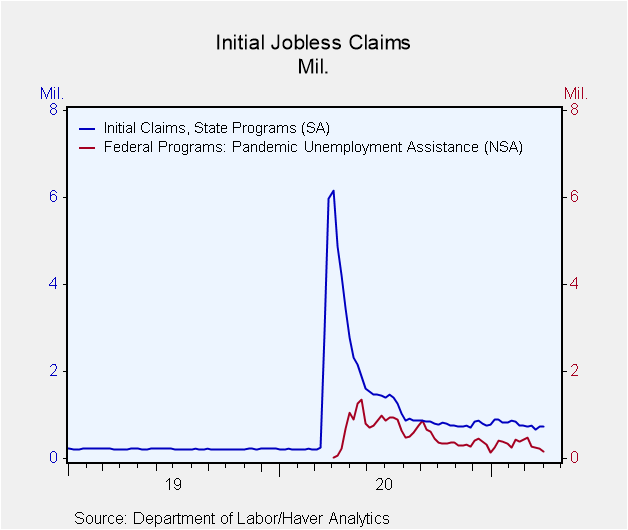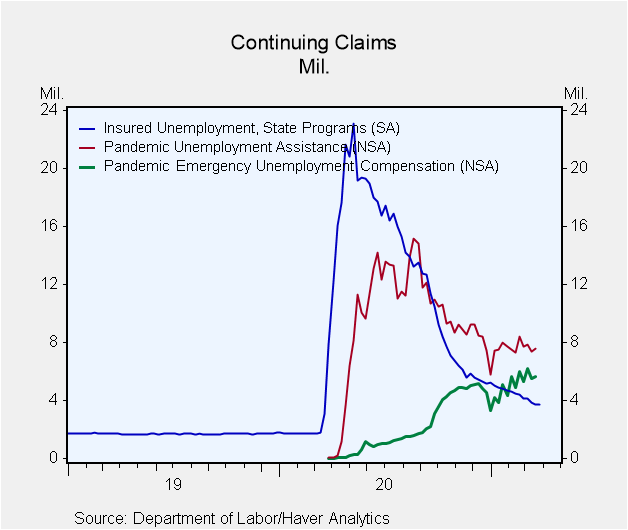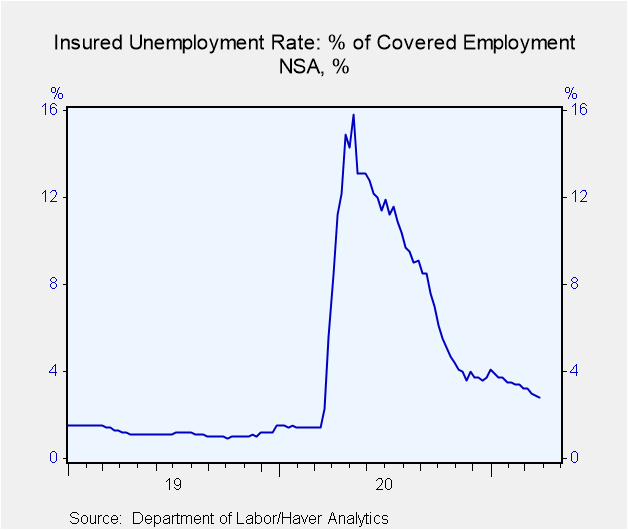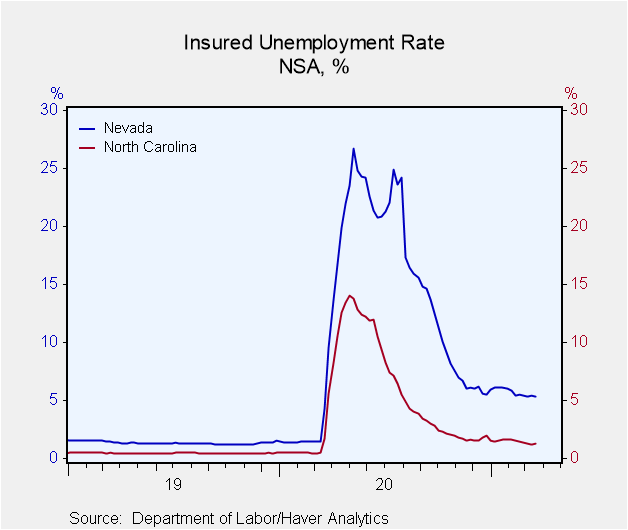 Global| Apr 08 2021
Global| Apr 08 2021U.S. Initial Unemployment Insurance Claims Unexpectedly Increase
by:Tom Moeller
|in:Economy in Brief
Summary
• Initial claims rise to highest level in three weeks. • Continuing claims ease. • Insured jobless rate remains steady. Initial claims for unemployment insurance rose to 744,000 during the week ended April 3 from 728,000 during the [...]
• Initial claims rise to highest level in three weeks.
• Continuing claims ease.
• Insured jobless rate remains steady.
Initial claims for unemployment insurance rose to 744,000 during the week ended April 3 from 728,000 during the prior week, revised from 719,000. The Action Economics Forecast Survey anticipated 690,000 initial claims for the latest week. The 4-week moving average rose to 723,750, up slightly from the previous week.
Initial claims for the federal Pandemic Unemployment Assistance (PUA) program fell sharply to 151,752 for the week ending April 3, from 237,065 in the previous week. It was the lowest level since the first week of January. The PUA program covers individuals such as the self-employed who are not included in regular state unemployment insurance. Given the brief history of this program, which started April 4, 2020, these and other COVID-related series are not seasonally adjusted.
Continuing claims for regular state unemployment insurance fell to 3.734 million during the week ended March 27 from 3.750 million in the previous week. The state insured rate of unemployment held steady at 2.6%, the lowest level since the third week of March of last year. Continuing PUA claims rose slightly to 7.554 million in the week ending March 20.
The number of Pandemic Emergency Unemployment Compensation (PEUC) claims rose modestly to 5.636 million from 5.516 million in the prior week. That program covers people who were unemployed before COVID but exhausted their state benefits. Extended PEUC benefits, which were included in the American Rescue Plan bill, totaled 786,962.
The total number of all state, federal and PUA and PEUC continuing claims fell slightly to 18.165 million, the lowest level since the first week of January. This grand total is not seasonally adjusted.
The state insured rates of unemployment continued to vary widely. In the week ending March 20, the highest insured unemployment rates were in Nevada (5.3%), Alaska (5.0%), Pennsylvania (5.0%), Connecticut (4.6%) and New York (4.1%). The lowest rates were in Alabama (0.8%), Utah (0.9%), South Dakota (1.2%), Nebraska (1.2%) and North Carolina (1.3%). Insured unemployment rates in other large states included California (3.7%), Texas (2.6%) and Florida (1.4%). These state rates are not seasonally adjusted.
Haver Analytics will stop seasonally adjusting U.S. claims data as we expect the revised Labor Department data to closely align with our adjusted series. We will continue to adjust state claims.
Data on weekly unemployment claims going back to 1967 are contained in Haver's WEEKLY database, and they are summarized monthly in USECON. Data for individual states are in REGIONW. The expectations figure is from the Action Economics Forecast Survey, carried in the AS1REPNA database.
| Unemployment Insurance (SA, 000s) | 04/03/21 | 03/27/21 | 03/20/21 | Y/Y % | 2020 | 2019 | 2018 |
|---|---|---|---|---|---|---|---|
| Initial Claims | 744 | 728 | 658 | -88 | 1,352 | 218 | 220 |
| Initial Claims (NSA) | 741 | 723 | 651 | -88 | 1,353 | 218 | 221 |
| Initial Claims Pandemic Unemployment Assistance (NSA) | 152 | 237 | 241 | -- | -- | -- | -- |
| Continuing Claims | -- | 3,734 | 3,750 | -53 | 10,380 | 1,699 | 1,754 |
| Continuing Claims (NSA) | -- | 4,032 | 4,099 | -51 | 10,370 | 1,704 | 1,763 |
| Continuing Claims Pandemic Unemployment Assistance (NSA) | -- | -- | 7,554 | -- | -- | -- | -- |
| Insured Unemployment Rate (%) | 2.6 | 2.6 |
3.0 |
7.1 | 1.2 | 1.2 |
Tom Moeller
AuthorMore in Author Profile »Prior to joining Haver Analytics in 2000, Mr. Moeller worked as the Economist at Chancellor Capital Management from 1985 to 1999. There, he developed comprehensive economic forecasts and interpreted economic data for equity and fixed income portfolio managers. Also at Chancellor, Mr. Moeller worked as an equity analyst and was responsible for researching and rating companies in the economically sensitive automobile and housing industries for investment in Chancellor’s equity portfolio. Prior to joining Chancellor, Mr. Moeller was an Economist at Citibank from 1979 to 1984. He also analyzed pricing behavior in the metals industry for the Council on Wage and Price Stability in Washington, D.C. In 1999, Mr. Moeller received the award for most accurate forecast from the Forecasters' Club of New York. From 1990 to 1992 he was President of the New York Association for Business Economists. Mr. Moeller earned an M.B.A. in Finance from Fordham University, where he graduated in 1987. He holds a Bachelor of Arts in Economics from George Washington University.










